SEO for Therapists: How It Works & Step-by-Step Guide (2025)
March 12, 2025
When it comes to SEO for therapists, there’s a LOT to say.
As a brand & website designer who often works with therapists, I’ve heard many of my clients say that they’re relying on referrals and directories like Psychology Today, which aren’t super consistent.
They work fine when they’re just starting, but then therapists realize that they can’t grow as much as they want to without a more proactive marketing strategy and online presence.
Enter: SEO for therapists, a sustainable marketing strategy that can help you connect with more potential clients and establish yourself as a thought leader in your specialization areas.
This is an in-depth guide on how mental health professionals can start showing up higher on search engine results (and why that matters in the first place!).
I’m going to go over both the theory and the more technical pieces of SEO strategies – including what to watch out for in 2025 with the rise of AI. Grab your favorite beverage, and let’s dive in! ☕
What Is SEO for Therapists?
SEO (Search Engine Optimization) is the process of improving your therapy website so it appears higher in Google search results when potential clients look for mental health services. SEO efforts can be a very important – and lucrative! – part of marketing for therapists.
For therapists, SEO means strategically using relevant keywords and creating genuinely helpful content that addresses the specific concerns and questions your target audience is searching for online.
When someone in your area searches, “anxiety therapist near me” or “depression counseling in [your city],” effective SEO helps your practice appear before your competitors. This visibility translates to more website visitors, more people getting in touch with you, and ultimately, more clients for your practice.
While you may have heard that SEO and blogging are “old-school,” 49% of marketers agree that organic search has the best ROI of any marketing channel.
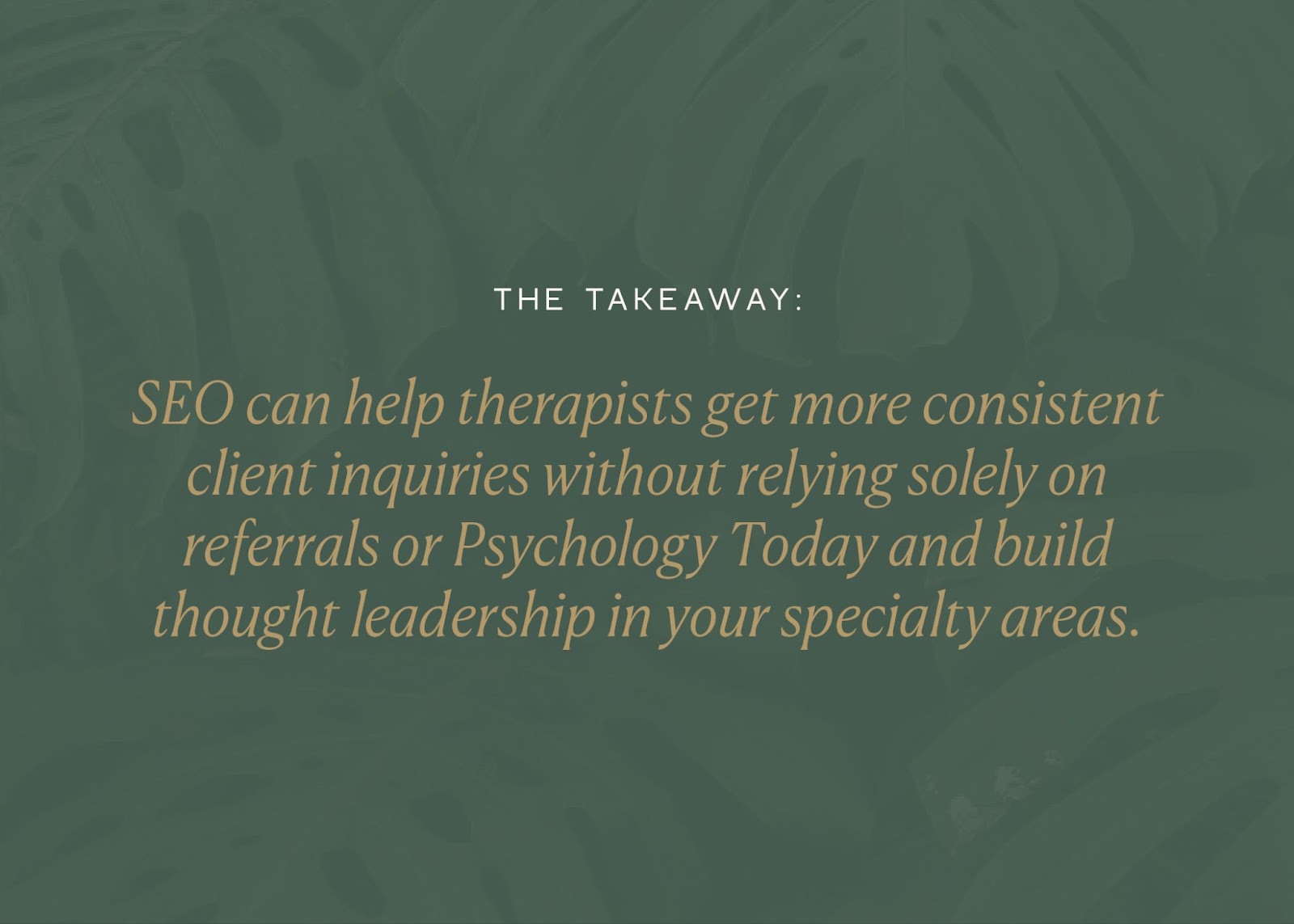
How Do I Build My SEO?
Google and other search engines look at your website holistically.
There are over 200 ranking factors in Google’s algorithm, so it’s impossible to master (or even know) all of them, but the most successful therapist websites aren’t necessarily the most technically perfect. They’re the ones that best understand and address the needs of the people they serve.
When you focus on genuinely helping your audience find answers, your SEO strategy naturally aligns with what Google values most.
That said, there are a few important factors to watch out for:
- Keyword research: You should identify keywords that your potential clients use when searching for therapy services in your area and specialty.
- On-page SEO: Your website pages have important elements, such as title tags and meta descriptions, that should be optimized for search engines.
- High-quality website: Your website should be fast, mobile-friendly, and easy to navigate. Take a look at these therapist website examples!
- Content marketing: Publishing helpful blog posts, resources, and FAQs to answer your target audience’s questions.
- Link building: Earning links from reputable websites that have to do with your geographical area or specialty boosts your authority in Google’s eyes.
- Technical SEO: There are a few important website backend things to watch out for, such as having a good site speed and taking care of broken links.
- Local SEO: If your private practice has ties to a specific geographic area (for example, if you see clients in person or if you’re only licensed in certain states), local SEO can help you appear in search results for that specific area.
If you’re nodding along but are not sure how to put all of this SEO for therapists’ information into practice, I’m going to break down all of these key elements in the following sections!
SEO Keywords for Therapists
Keywords are the specific words and phrases that your potential clients type into search engines like Google.
For example, they may be looking for an “anxiety therapist in Columbus, Ohio.” They can also look for answers to questions like “how long does ED recovery take.”
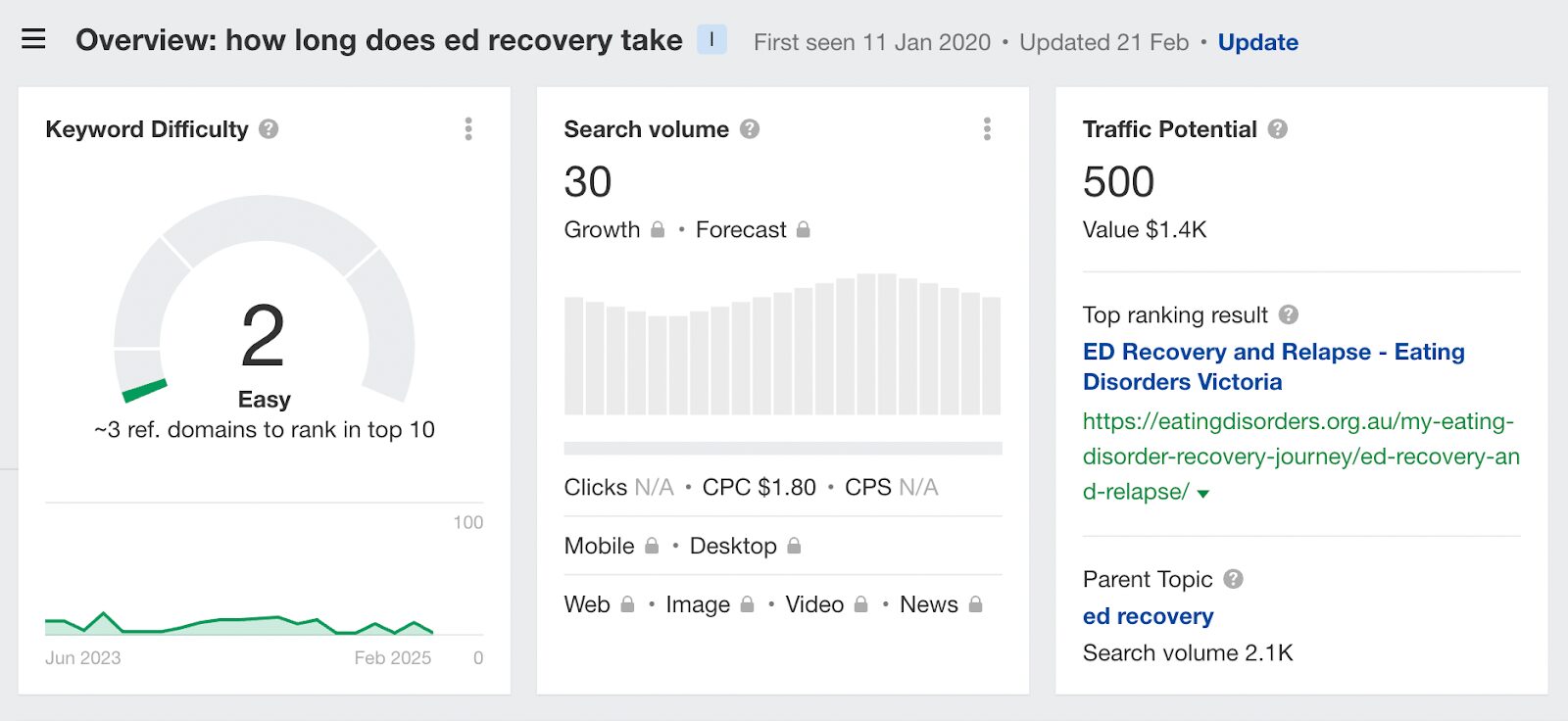
When you know what keywords your target audience is searching for, you can create content that matches their questions and gives them helpful information.
This is, essentially, how SEO works – you give people genuinely helpful information that they’re already looking for.
Choosing the Right Keywords
Keywords typically fall into two categories.
- Short-tail keywords are brief, general terms like “therapist” or “anxiety therapy.”
- Long-tail keywords are longer, more specific phrases like “trauma-informed therapist in Chicago” or “marriage counselor for blended families.”
I recommend using long-tail keywords for all of your website pages. They generally have less competition, which means that it’s easier to rank for them – even if your website is relatively new.
They also bring in highly targeted traffic – the people who search for these very specific terms know exactly what they’re looking for and are more likely to book a consultation when they find you.
This works especially well if you have a specialized therapy niche or approach!
Each page on your website should target one primary keyword. Don’t create multiple pages targeting the same keyword (ex: a services page and a blog post both targeting “anxiety therapy for teens” as their primary keyword).
This creates internal competition and confuses search engines about which page to rank. It’s a much better practice to create one in-depth page on one specific topic and update it over time if you have something new to say.
What Tools to Use
There are SO many SEO tools to choose from, and, unfortunately, many of them are expensive – which is not ideal if you’re just starting your private practice or just don’t have time to learn how to effectively use a robust SEO tool (they’re not always intuitive!).
My favorite free keyword research tool is Ubersuggest. I find it to be easier to use than many others, and it has enough features to find the right target keywords. For paid tools, I recommend Ahrefs (although they do have a limited free version!).
You can also type your best keyword guess into Google and scroll to the bottom to see related searches. This is a sneaky – and completely free! – way to find some good target keywords.
For example, I typed in “therapist in Columbus, Ohio” into Google, and here are related searches that came up:
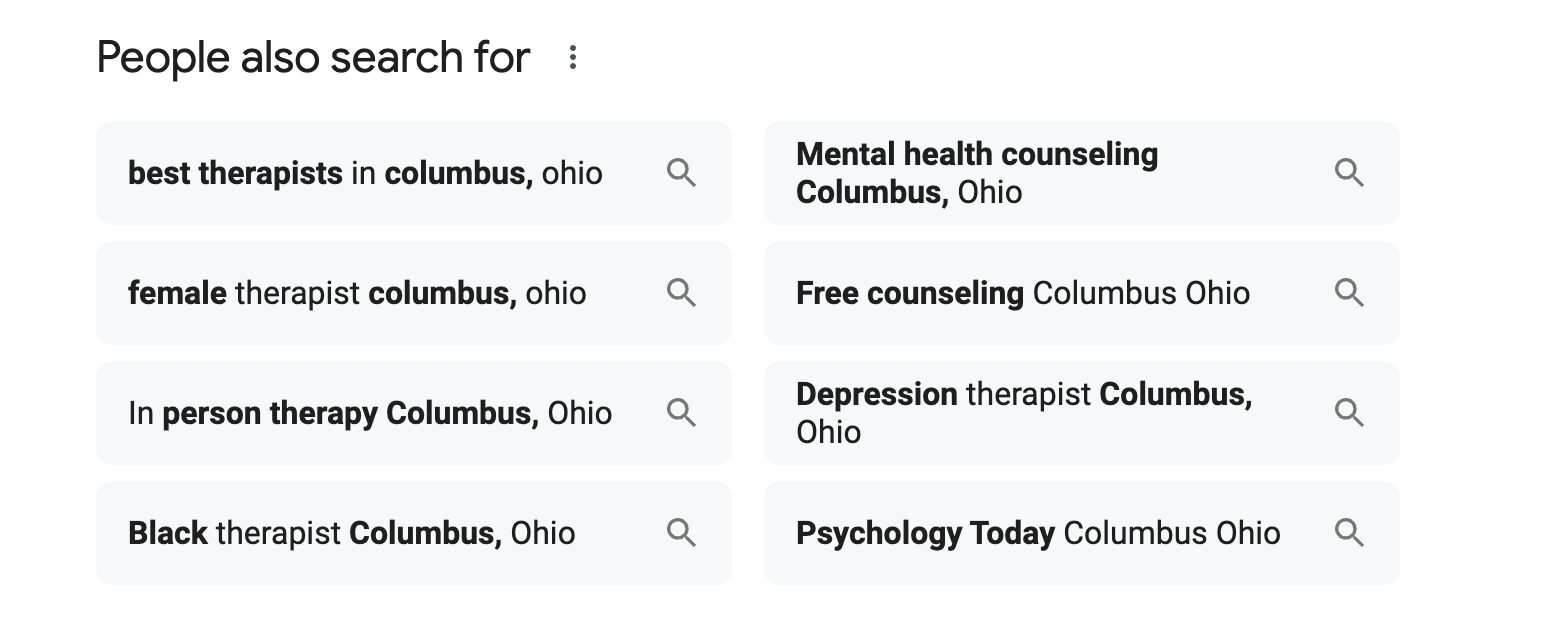
This gives you a decent idea of what people in this area are searching for, and if you fit any of these target keywords – such as “depression therapist Columbus, Ohio,” for example – you could incorporate them into one of your website pages.
If you’re looking for a more advanced keyword research process, learn how to use a paid SEO tool or work with an SEO pro, such as an SEO copywriter.
On-Page SEO for Therapists
Let’s get a little technical! 🤖
On-page SEO refers to the backend elements of your website content that you can directly control and optimize. These elements help Google understand what your web pages are about and figure out how to rank them in someone’s search.
There are quite a few on-page SEO elements, but we’ll take a closer look at title tags, meta descriptions, images, and page headings.
Title Tags
The title tag is the clickable headline that appears in search results. It’s like the title of a book that tells both Google and potential clients what your page is about. With that analogy, can you tell that before becoming a Showit website designer for creatives, I was an English major in college? 🤓

For therapists, effective title tags should include your primary keyword near the beginning, be 50-60 characters long (or Google will cut it off), and clearly describe the page content.
You can also include your practice name when appropriate. For example, your home page title tag can look something like “Anxiety Therapy for Teens in Portland | [Your Practice Name].”
Meta Descriptions
The meta description is the summary that appears under your title in search results. While they’re not a direct keyword ranking factor, Google states that high-quality meta descriptions “can go a long way to improving the quality and quantity of your search traffic.”
So, in simple words, they can be very helpful when it comes to SEO for therapists and other creative entrepreneurs.

Your meta descriptions should be 150-160 characters long and offer a clear benefit or answer a question. If it can naturally incorporate your target keyword for that page, that’s even better, but don’t force it – Google will see right through it! 😉
Images
The photos and images that you use on your therapist website need to be optimized for SEO, too! Here are a few strategies you should implement for better search engine optimization:
- Use descriptive, keyword-rich file names before uploading (anxiety-coping-skills.jpg, not IMG12345.jpg)
- Add alt text that describes the image and includes keywords when natural
- Compress images so they’re sized for web (500KB or less) to keep your site loading quickly
- Use relevant images that go along with your website content
If you’re just starting your private practice or are going through a rebrand and need to take new brand photos, use these brand photo shoot tips!
Page Headings
Headings organize your content in a hierarchy that helps both readers and search engines understand your page structure. Different parts of your website pages have different levels of importance, and the internal heading structure should reflect that!
- H1 tag: The main headline of your page – use only one H1 per page that includes your primary keyword
- H2 tags: Major section headings that can include secondary keywords
- H3 tags: Sub-sections within H2 sections
- Paragraph: Normal text
- Nav: Navigational text (ex: links)
- Div: Separation elements
Try to incorporate target keywords in as many headings as you can, but don’t stuff them. For the best on-page optimization, your content should sound as natural as possible.
SEO and Your Website
Your website structure is VERY important for SEO success.
Clear navigation helps both visitors and search engines understand your therapy practice, so aim for a clean and simple design.
- Create a logical menu structure with main categories like “Services,” “About,” “FAQ,” and “Contact.” Limit your main navigation to 5-7 items to avoid overwhelming visitors. Within each section, organize related content in a way that makes sense to someone seeking therapy services.
- Your website should load quickly on both computers and phones. Slow websites frustrate potential clients and receive lower rankings from Google. Your desktop design should also adjust automatically to different screen sizes.
- Don’t forget to submit your sitemap to Google Search Console. A sitemap is like a roadmap of your website that helps Google find and index all your pages. This step helps Google know about every page on your private practice website.
Website design is where many mental health professionals get stuck because it requires you to be creative AND technical.
If you need a new website for your private practice, learn more about my design services!
Being Specific
Your potential clients are looking for a therapist who specializes in their specific challenges. If someone struggles with anxiety, they want a therapist who deeply understands anxiety – not just a general therapist.
Google understands this, too. If you have different target audiences, it’s very hard (read: impossible) to write one services page that directly speaks to all of them. These “general” services pages will always rank lower in search engine results pages than more targeted ones.
If you treat multiple types of concerns, it’s important to create dedicated services pages (ex: “Anxiety Therapy,” “Couples Counseling Services,” etc.) OR create separate blog posts about these specific services.
Google increasingly prioritizes helpful, specific content. For example, if people search “therapy for new moms in Columbus, Ohio,” create content precisely addressing this need. You can include things like:
- Specific challenges new mothers face
- How your therapy approach helps these challenges
- Common questions from new mothers seeking therapy
- What happens during a session
- Insurance and payment information
- Reassurance that their struggles are valid and that treatment can help
Write for real people first, not search engine rankings. When your content genuinely helps visitors understand how you can address their specific needs, Google recognizes this value.
Personal, authentic content that connects emotionally with potential clients will always outperform content that feels generic or keyword-stuffed.
SEO Marketing for Therapists
Building your private therapy website with SEO in mind is the first step, but the best SEO growth comes from a solid content marketing strategy and regular blogging.
When you regularly publish helpful articles that answer the questions or concerns that your target audience has, you build both your visibility on Google and your credibility with potential clients.
A therapy blog allows you to target valuable keywords that don’t fit naturally on your main service pages. For example, your anxiety therapy services page can target the keyword “anxiety therapist in [city],” but your blog can address specific questions like “how to stop panic attacks at work” or “managing social anxiety during holidays.”
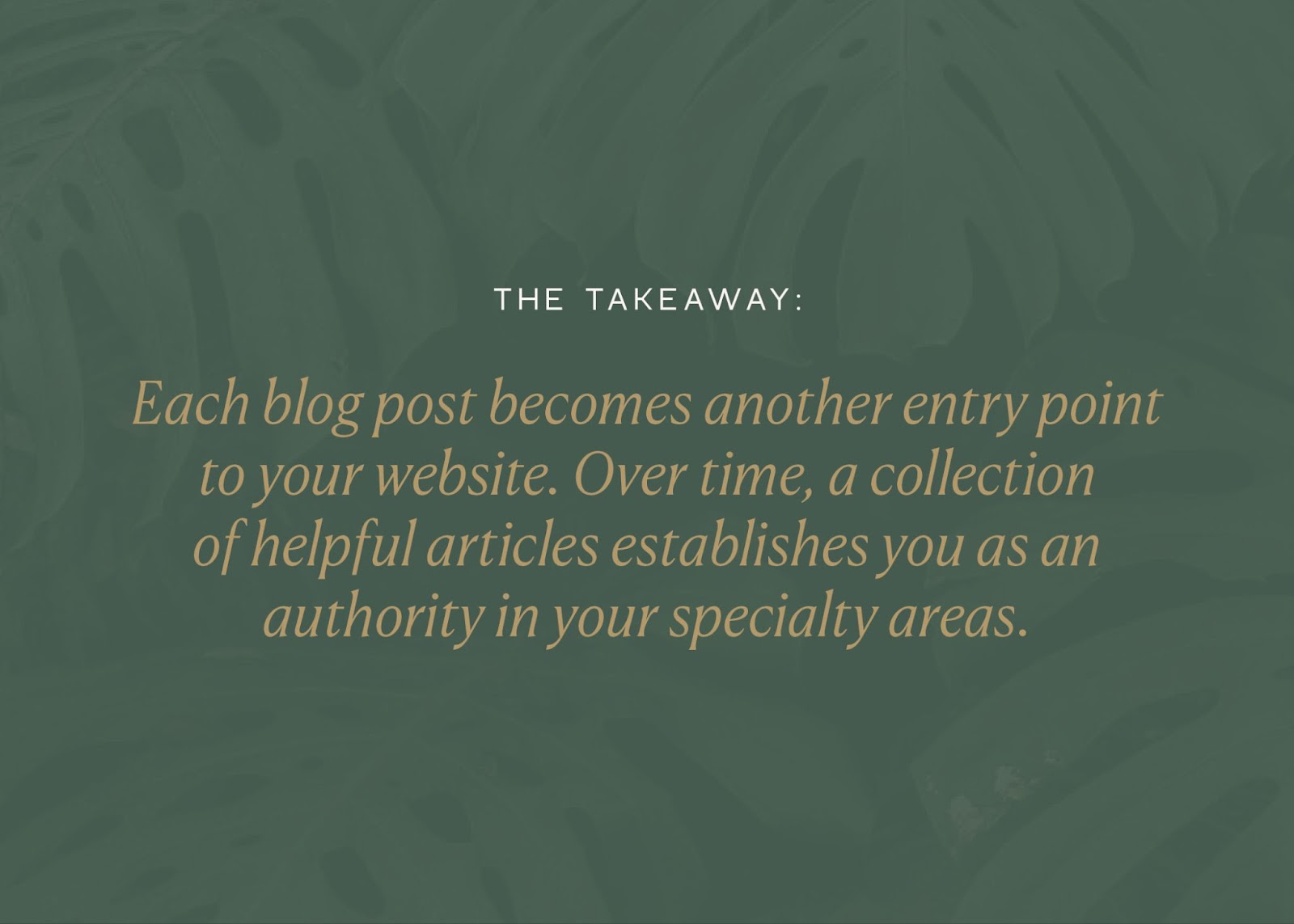
How to Start Blogging
When I create Showit websites for my therapist clients, I always recommend that they start a blog. One of the reasons why Showit is my favorite website builder is that it integrates with WordPress for blogging, which can give your SEO a boost!
If you’re ready to start a blog, here’s what I’d do:
- Identify valuable blog post topics: Do keyword research to figure out what your target audience is searching for and find keywords that are realistic for your domain to rank for. You should look for keywords with a high search volume (anywhere above 20) and low keyword difficulty (KD).
- Create a content calendar: Plan your blog topics, and do your best to be consistent. Focus on quality over quantity – one in-depth post will get you much better results than four rushed ones.
- Write high-quality content: Create comprehensive, genuinely helpful articles that truly answer the searcher’s question. Make them easy to read and follow, and make sure they’re at least 1,500 words or more. Google prioritizes long-form content.
- Structure for readability: Break content into sections with descriptive headings that naturally incorporate your target keywords. Use short paragraphs, bulleted lists, and occasional bolding to make the content easy to scan (no one is going to read every single word of your post, so emphasize the most important parts you don’t want people to miss!).
- Include a gentle call to action: End posts with a simple invitation like “If you’re struggling with these issues, our therapists specialize in [your focus]. Book a consultation here.”
If you don’t want to write blog posts yourself, you can hire a blogger who’s well-versed in SEO services – this can save you major time and energy!
Google’s Helpful Content Update
Google’s Helpful Content Update is a huge algorithm change that rewards content created primarily to help people, not just to rank in search results. For therapists, this update is actually good news if you’re creating authentic, valuable content.
The update specifically targets content that feels shallow, generic, or written primarily for search engines instead of humans.
Content mills that produce high volumes of low-quality mental health articles are being penalized. Genuine experts who publish content that matches search intent and has depth and insight are rewarded. In my opinion, this is awesome. 👏
To align with this update, focus on writing from your professional expertise and genuine desire to help. Address real questions and concerns your clients have, provide a lot of helpful information, and write in a natural tone.
Link Building
Link building is one of the most important ranking factors, and it’s not as scary as it sounds. It’s simply the process of getting other websites to link to your therapy website. It’s also sometimes called “off-page SEO.”
Google sees relevant backlinks as a vote of confidence in your content, a sign that others find your site valuable and trustworthy. The more quality links point to your website, the more Google sees you as an authority in your field.
As always, the quality of the backlinks matters. A single link from a respected mental health organization or local news site is worth more than dozens of links from unrelated or low-quality websites.
For example, if you’re a therapist, a backlink from a website about cryptocurrency trading or fast fashion won’t be useful for your rankings (and may even be harmful). On the other hand, a backlink from a local physicians’ group or a respected mental health nonprofit like NAMI will give you a nice SEO boost.
Directories
Therapist-specific directories like Psychology Today and TherapyDen are helpful when you want to connect with clients, but they’re less helpful when it comes to building backlinks.
Many – if not most – therapists have these backlinks, so Google doesn’t see them as particularly unique or valuable.
So, instead, you should focus on niche directories specific to your specialty and local business directories like Yellow Pages, Yelp, and your Chamber of Commerce. Healthcare-specific platforms where not every therapist is listed and community resource lists can also be helpful.
Essentially, the idea is that you should go after more unique directories than the ones that every other therapist has, too.
Guest Blogging
Writing articles for other websites in your field allows you to share your expertise AND earn quality backlinks. You can approach adjacent health businesses, such as primary care physician groups and wellness centers, or even other mental health professionals who focus on a different niche.
Just make sure that they link back to your website, not your social media accounts (this won’t earn you backlinks).
Podcasting
Appearing as a guest on podcasts builds your authority and often results in links from the podcast’s website. Look for podcasts covering mental health and wellness, especially if they’re in your niche, and pitch them specific topics where you have unique expertise.
Again, make sure that they link back to your website!
PR & Media
Eventually, you may consider working with a PR professional or taking a more DIY approach to getting some public spotlight. For example, you can reach out to local newspapers, TV stations, and online publications offering to comment on mental health stories.
Creating Thought-Leadership Content
Developing unique and authoritative content naturally attracts links from others in your field. When you write comprehensive, deeply researched articles that become reference points for others, people start mentioning the insights you share and linking back to your website.
Don’t just repeat the content that other articles are sharing, but put YOUR unique spin on it! Google now prioritizes personal experience and expertise, so the more true the content is to you, the better.
Technical SEO
Technical SEO is the behind-the-scenes elements of your website that help search engines crawl, index, and rank your content. Your keyword research and content are the “visible” elements of SEO, and technical SEO is more of a foundation for it all.
Addressing these basics can help you improve your search rankings:
- Website speed: Pages that load slowly are annoying for your visitors, and Google will likely penalize you for it. Compressing images and upgrading your hosting if your site consistently loads slowly can help. Google’s PageSpeed Insights can help you see where your website is falling short.
- Mobile optimization: More than half of all web traffic comes from mobile devices. Your therapy website must display correctly and be easy to navigate on smartphones and tablets.
- Secure website (HTTPS): Having a secure website (with a URL starting with “https” instead of “http”) is super important, especially for something as sensitive as a therapy practice. You should also make your website HIPAA-compliant.
- Broken links: Regularly check for and fix any broken links on your site. These create poor user experiences and can negatively impact your SEO. I often use Dead Link Checker to check for this!
- Duplicate content: It’s not a good idea to have multiple pages with very similar content. This confuses Google about which page to rank. Each of your website pages should have a distinct purpose and unique content
Technical SEO is often intimidating for therapists, but most of these problems can be solved by working with a designer who understands SEO instead of just paying attention to the aesthetics. The aesthetics are super important, but it’s also essential to back them up with a solid backend!
Local SEO for Therapists
Local SEO allows you to connect with potential clients in your local area. For therapists, local search visibility is particularly important since many of them see their clients in person or are only licensed to see clients who live in certain states.
When someone searches “therapist near me” or “anxiety therapist in [your city],” Google uses different ranking factors than for general searches.
You can take these steps to improve how your website comes up in local search queries:
- Make sure that your name, address, and phone number (NAP) are consistent across all of your website pages and online platforms
- Build citations on relevant local directories and websites
- Collect and manage client reviews
- Create location-specific content
- Optimize your Google Business Profile
The SEO for therapists elements that I’ve explained in this guide before still apply – they just have to be more focused on local keywords. For example, instead of targeting a general keyword like “trauma therapy techniques,” you’d focus on “trauma therapy in Boston.”
On-Page Local SEO for Therapists
If you have a physical office location, make sure to naturally incorporate it throughout your website so that Google understands where you provide services.
You can include your city or neighborhood names in strategic places like:
- Page titles (e.g., “Eating Disorder Therapist in Columbus, Ohio”)
- Headers (H1, H2) where relevant
- In your blog content
- Image alt text when it makes sense
- URL structures for location-specific pages
Just make sure to avoid “keyword stuffing” and unnaturally forcing location terms into your content.
Writing something like “Our Portland therapy practice provides Portland therapy services for Portland residents seeking Portland anxiety counseling” WILL harm your SEO.
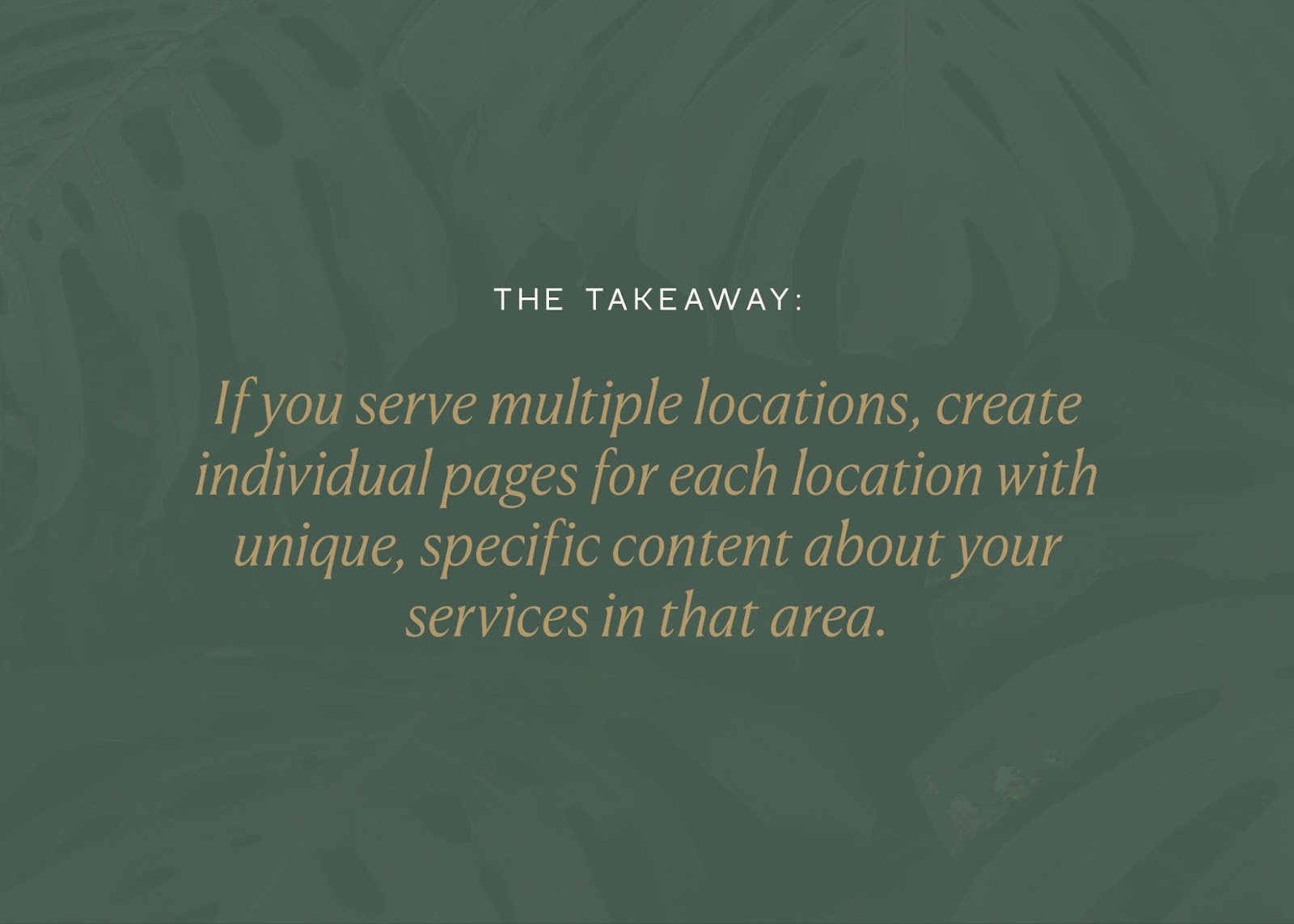
Google Business Profile
Your Google Business Profile is an awesome tool for local SEO for therapists. It’s completely free, and it helps your private practice appear in Google Maps and local search results.
To optimize your Google Business Profile, you should first claim and verify your listing if you haven’t already. Then, complete every section of your profile, including your services and business description, and add high-quality photos of your office.
Is SEO Worth It for Therapists?
SEO is definitely worth the investment for therapists who want to build a sustainable private practice.
Once you’ve established good rankings, SEO continues working for you around the clock, and many therapists find that a well-optimized website becomes their most reliable source of new client inquiries.
You can also still use other marketing channels, like social media or even paid Google ads, together with SEO. You don’t have to choose just one way to improve your visibility!
At the same time, it’s VERY important to understand that SEO is a long-term strategy. Even when you make the most intentional changes, results can take 3-6 months for relatively established websites and 6+ months for new websites.
SEO for Therapists in 2025
Some therapists worry that the rise of AI is going to make SEO irrelevant, but I believe that it’s simply changing how we approach it.
Google now places even higher value on authentic, experience-based content that only humans can create. As a therapist, your personal insights and professional perspectives are exactly what Google wants to highlight.
AI can produce general mental health information and speed up the writing process, but it can’t replicate your unique therapeutic approach or the distinctive way you explain concepts to clients. These personal elements are becoming VERY important for search rankings.
I personally think that AI can be a great tool. It’s awesome for helping you organize your thoughts and edit your content. AI-assisted content is 100% fine with Google, and it won’t hurt your SEO rankings.
However, Google has gotten better at identifying content that’s entirely AI-generated with no human input or expertise added. It’s NOT a good idea to publish purely AI-created therapy articles with no original takes.
In 2025 and beyond, successful SEO for therapists will lean heavily on the human elements of your practice, such as your empathy, your specialized expertise, and the unique way you connect with clients.
It’s becoming increasingly important to become ultra-specific in your branding as a therapist and, essentially, position your private practice in the most human way possible. AI can take care of the repetitive busywork, and you should focus on what makes you uniquely you.
Should I Do SEO Myself?
You can try to DIY your SEO…but you probably shouldn’t – unless you’re following a course or learning from an SEO specialist!
There are so many elements that go into effective SEO, from figuring out which keywords to target to technical aspects like the speed of your website.
Your first step should be building an SEO-friendly website, and it’s much easier to do that working with a designer who understands SEO versus trying to do it all yourself.
Many therapists who attempt to create their own websites end up with beautiful designs that, unfortunately, lack the structural elements search engines need to properly rank them.
DIY SEO can ultimately come with costly mistakes.
For example, choosing the wrong keywords might mean spending months creating content that never brings in clients. Not to mention that technical errors can prevent Google from properly indexing your site, which means that it’ll stay invisible in search results even if you regularly publish high-quality content.
After your website is launched with a solid SEO foundation, you can think about working with an SEO blogger or writing your content yourself. But you need that healthy website foundation first!
The bottom line is that your time is valuable. The hours you’ll spend learning SEO and troubleshooting issues are hours not spent seeing clients or developing your practice in other ways.
Grow Your Practice with SEO-Friendly & Earthy Website Design for Therapists
SEO’s ultimate goal is to clearly communicate the unique value you offer as a therapist in a way that both search engines and your potential clients can easily understand.
Learn more about my website design services to get started!

About the Author:
Rose Benedict
Owner and Designer, Rose Benedict Design
Rose Benedict is a brand and website designer for therapists, creatives, artists, and service providers. Rose is also a Showit Design Partner and the owner/designer at Rose Benedict Design. She has been a designer for the past 10 years and has worked at a Fortune 15 company and top university in Columbus, Ohio. She brings both her brand/website design and technical experience to small business owners so that they can thrive and deeply connect with their ideal clients. Outside of work, Rose loves reading, pilates, gardening, and traveling (10 countries and counting!).
Rose Benedict Design is a brand and Showit web designer based in Columbus, Ohio, devoted to crafting beautiful, strategic brands for creatives and service providers.
©2022-2024 ROSE BENEDICT DESIGN
Rose Benedict Design is a proud Showit Design Partner.